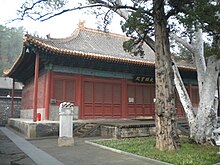Fahai Temple
This article does not cite any sources. (June 2019) |
| Fahai Temple | |
|---|---|
 The Fahai Temple | |
| Religion | |
| Affiliation | Buddhism |
| Location | |
| Location | Beijing |
| Country | China |
| Geographic coordinates | 39°56′24.36″N 116°9′11.88″E / 39.9401000°N 116.1533000°ECoordinates: 39°56′24.36″N 116°9′11.88″E / 39.9401000°N 116.1533000°E |
| Architecture | |
| Completed | 1443 |
The Fahai Temple (Chinese: 法海寺; pinyin: Fǎhǎi Sì; धर्म समुद्र विहार Dharma Samudra Vihāra) is Ming Dynasty Buddhist temple located at the foot of Cuiwei Mountain, about two kilometers to the north-east of Moshikou, Shijingshan District, Beijing, China. It was declared as a national cultural relic protection unit in 1988. It is located within Fahai Temple Forest Park.
History[]
Construction of the Fahai Temple started in 1439 during the Ming dynasty and was completed in 1443.
Frescoes[]

The most distinguishing part of Fahai Temple is the Ming dynasty frescoes. The total area of the frescoes is 236.7 square meters. Comparing with other famous frescoes in China, such as the Yongle Palace frescoes and the Dunhuang frescoes, Fahai Temple's well-preserved frescoes are also notable in the depiction of figures, subtlety of patterns and the craft methods.
Cultural relics[]
- Bronze Bell
| Wikimedia Commons has media related to Fahai Temple. |
- Major National Historical and Cultural Sites in Beijing
- Buddhist temples in Beijing
- Arts in China


